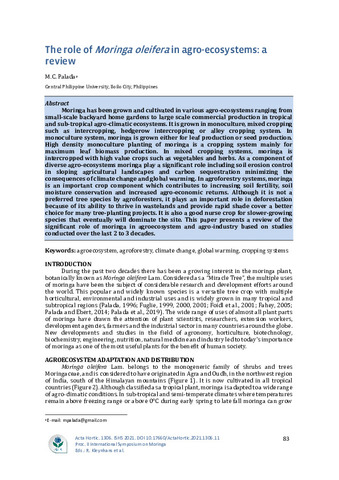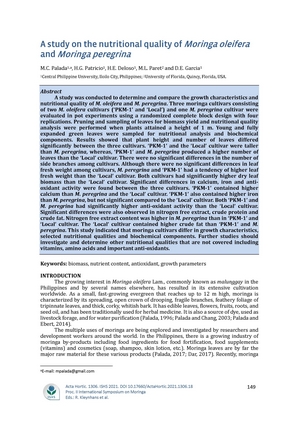The role of Moringa oleifera in agro-ecosystems: A review

Request
Request a full text copyPage views
1,358Дата
2021-03Автор
Share
Metadata
Показать полную информацию
Аннотации
Moringa has been grown and cultivated in various agro-ecosystems ranging from small-scale backyard home gardens to large scale commercial production in tropical and sub-tropical agro-climatic ecosystems. It is grown in monoculture, mixed cropping such as intercropping, hedgerow intercropping or alley cropping system. In monoculture system, moringa is grown either for leaf production or seed production. High density monoculture planting of moringa is a cropping system mainly for maximum leaf biomass production. In mixed cropping systems, moringa is intercropped with high value crops such as vegetables and herbs. As a component of diverse agro-ecosystems moringa play a significant role including soil erosion control in sloping agricultural landscapes and carbon sequestration minimizing the consequences of climate change and global warming. In agroforestry systems, moringa is an important crop component which contributes to increasing soil fertility, soil moisture conservation and increased agro-economic returns. Although it is not a preferred tree species by agroforesters, it plays an important role in deforestation because of its ability to thrive in wastelands and provide rapid shade cover a better choice for many tree-planting projects. It is also a good nurse crop for slower-growing species that eventually will dominate the site. This paper presents a review of the significant role of moringa in agroecosystem and agro-industry based on studies conducted over the last 2 to 3 decades.
Описание
Conference paper
Suggested Citation
Palada, M. C. (2021). The role of Moringa oleifera in agro-ecosystems: A review. In Kleynhans, R. , Laurie, S. M. , Chimuka, L. K. & du Toit, E. S. (Eds)., II International Symposium on Moringa (pp. 83-97). International Society for Horticultural Science. https://doi.org/10.17660/ActaHortic.2021.1306.11
Type
Conference paperISSN
0567-7572; 2406-6168ISBN
978-94-62613-05-8Тематика
Keywords
Серии
ISHS Acta Horticulturae;1306Collections
Связанные элементы
Просмотр элементов, связанных по названию, автору, создателю или теме.
-
A study on the nutritional quality of Moringa oleifera and Moringa peregrina
Palada, Manuel C.; Patricio, Hope G.; Deloso, Homer E.; Paret, Mathews; Garcia, D. E. (International Society for Horticultural Science, 2021-04-15)A study was conducted to determine and compare the growth characteristics and nutritional quality of <em>M. oleifera</em> and <em>M. peregrina</em>. Three moringa cultivars consisting of two <em>M. oleifera</em> cultivars ... -
Evaluation of the efficacy of essential oil from moringa leaves (Moringa oleifera) against Staphylococcus epidermidis
Mañosa, Rhegil Joseph B. (2024-04)Staphylococcus epidermidis is a coagulase-negative and gram-positive bacterium that can cause arthritis, tendinitis, tenosynovitis, osteomyelitis and omphalitis in poultry animals. It is the most common cause of nosocomial ... -
Brooding performance of Philippine native chicken supplemented with moringa (Moringa oleifera Lam.) and hot red pepper (Capsicum annum L.) as mineral and vitamin premix
Servidad, Layka A. (2019-04)The study was conducted from February 21 to March 14, 2018 at CPU-CARES Research and Development Learning Center, Jaro, Iloilo City. The study was conducted to determine the brooding performance of Philippine native chicken ...





